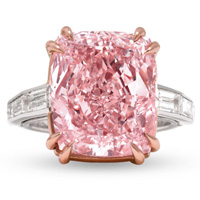Princie Pink Diamond Has Prodigious Pedigree
April 10th, 2013 by Noam Flint
In some alternate universe, nature buried most of her precious gems under lands that were historically populated by light-skinned people. Half a century ago on this other-Earth, one of the Northern royals traveled from the “mysterious” Occident to the “enlightened” Orient, in order to sell one of the largest and most magnificent gems dug up in Europe. In the commercial capital of Accra, a group of merchants decided to dub this special stone “Dukie”, after the royal’s pimply-faced pre-teen son who had tagged along for the trip.
Sounds silly, right? Well, so is the weird nickname that Van Cleef & Arpels gave the 34.65-carat cushion-cut vs2 fancy intense pink diamond that will be sold at Christie’s auction on April 16th, 2013. For a stone that is expected to sell for somewhere between $30 and $40 million, they could have come up with a more distinguished name than the “Princie”. Perhaps the PR team at London branch of Van Cleef were purposefully slagging the stone, in order to drive down the price. Back in 1960, they ended up acquiring the diamond for the equivalent of only $70,000 – probably one of the best diamond investment stories on record.

The Majestic Pink Diamond (image by R.A.U Antiques)
In spite of this disrespectful name (just think of the Majestic Pink, the Martian Pink or the Incomparable), we will return its well-deserved honor by graphically illustrating the gem’s beautiful backstory so that you can fully appreciate its significance. If the Princie’s potential purchasers read about its origins, they’ll understand the stone’s true value and probably increase their bids.
For more than two centuries between the early 1500′s and the mid-1700′s, the Mughal Empire ruled over the entire Indian subcontinent and its estimated 150 million residents – about a quarter of the population of the planet at that time. As their name implies, the Mughal emperors were direct defendants of Mongolia’s Genghis Khan. At the peak of their power, stronger than any other nation in the world, they built the Taj Mahal and many other architectural marvels. Even after the empire eventually disintegrated, the Hyderabad region retained princely, then protectorate status. When India and Pakistan became UN member states in 1948, Hyderabad’s hereditary Nizam retained the right to join either side.
Up until the 20th century, Hyderabad was the sole supplier of rough diamonds to the global market. The Nizam was so affluent that he used the $150 million Jacob diamond as a mere paperweight! In 1937, Time Magazine called Nizam Asaf Jan VII, Mir Osman Ali Khan the richest man in the world and estimated his total wealth to be the equivalent of $33 billion in today’s dollars. So why did the Nizam need to auction off a pink diamond in 1960 for a measly $70,000? It would seem that his fortune began to wane as his progeny began to wax; the man is known to have sired at least 149 children with seven wives and 42 concubines. The Princie diamond, extracted from the Golconda mines, was named after one of the 149.
UPDATE (17 Apr 2013):
The Princie was sold at the NY auction for the astounding price of $39.3 Million Dollars ($1,135,000 per carat) to an anonymous bidder. This makes it the most expensive diamond sold by Christie’s, a close match to the Sotheby’s record of $46.2 Million Dollars (also for a pink diamond).
This also makes it the record for the most expensive diamond sold on a USA auction.
Here is the video of the actual sale:
* Image credit Christie’s